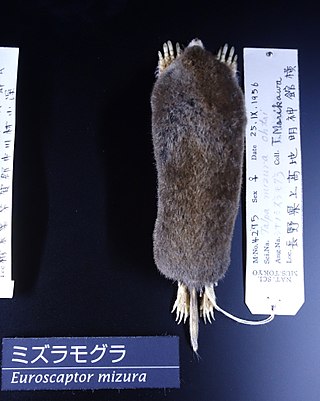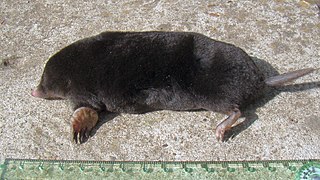
Moles are small mammals adapted to a subterranean lifestyle. They have cylindrical bodies, velvety fur, very small, inconspicuous eyes and ears, reduced hindlimbs, and short, powerful forelimbs with large paws adapted for digging.

The family Talpidae includes the moles who are small insectivorous mammals of the order Eulipotyphla. Talpids are all digging animals to various degrees: moles are completely subterranean animals; shrew moles and shrew-like moles somewhat less so; and desmans, while basically aquatic, excavate dry sleeping chambers; whilst the quite unique star-nosed mole is equally adept in the water and underground. Talpids are found across the Northern Hemisphere of Eurasia and North America, and range as far south as the montane regions of tropical Southeast Asia.

The European mole is a mammal of the order Eulipotyphla. It is also known as the common mole and the northern mole.

The subfamily Talpinae, sometimes called "Old World moles" or "Old World moles and relatives", is one of three subfamilies of the mole family Talpidae, the others being the Scalopinae, or New World moles, and the Uropsilinae, or shrew-like moles.

Talpa is a genus in the mole family Talpidae. Among the first taxa in science, Carolus Linnaeus used the Latin word for "mole", talpa, in his Regnum Animale to refer to the commonly known European form of mole. The group has since been expanded to include 13 extant species, found primarily in Europe and western Asia. The European mole, found throughout most of Europe, is a member of this genus, as are several species restricted to small ranges. One species, Père David's mole, is data deficient. These moles eat earthworms, insects, and other invertebrates found in the soil.

Strandzha is a mountain massif in southeastern Bulgaria and East Thrace the European part of Turkey. It is in the southeastern part of the Balkans between the plains of Thrace to the west, the lowlands near Burgas to the north, and the Black Sea to the east. Its highest peak is Mahya Dağı in Turkey, while the highest point on Bulgarian territory is Golyamo Gradishte. The total area is approximately 10,000 km2 (3,861 sq mi).

The Japanese mountain mole is a species of Old World mole in the family Talpidae. It is endemic to Japan. It is the only member of the monotypic genus Oreoscaptor. Its natural habitats are temperate forests and temperate grassland.

The Caucasian mole is a mammal in the family Talpidae that is endemic to the Caucasus Mountains of Russia and Georgia.

The Spanish mole is a species of mammal in the family Talpidae. It is found in Spain and Portugal.

The Balkan mole is a species of mammal in the family Talpidae. It is found in Montenegro, Albania, North Macedonia and Greece, including the island of Corfu.

Talpini is a tribe of mammals known as Old World Moles. It is a division of the subfamily Talpinae.

The Rup dialects, or the Southeastern dialects, are a group of Bulgarian dialects located east of the yat boundary, thus being part of the Eastern Bulgarian dialects. The range of the Rup dialects includes the southern part of Thrace, i.e. Strandzha, the region of Haskovo, the Rhodopes and the eastern half of Pirin Macedonia.

The Scalopinae, or New World moles, are one of three subfamilies of the family Talpidae, which consists of moles and mole-like animals; the other two subfamilies being the Old World talpids and the Chinese shrew-like moles (Uropsilinae). The Scalopinae are the only Talpidae subfamily to consist entirely of undisputed moles and no mole-like close relatives such as shrew-moles or desmans.

Strandzha Nature Park is the largest protected area in Bulgaria spanning a territory of 1,161 square kilometres (448 sq mi) in the Strandzha Mountain in the extreme south-eastern corner of the country on the border with Turkey. It was established on 25 January 1995 to protect ecosystems and biodiversity of European importance, as well as the traditional cultural, historical and folklore heritage of the region. The altitude varies from 710 metres (780 yd) on Gradishte Peak to 0 metres (0 yd) at the Black Sea coast with average length of 50 kilometres (31 mi) from west to east and 20 kilometres (12 mi) from north to south.

The Aquitanian mole is a species of small burrowing mammal of the family Talpidae. It is found from the southwest of France to the north of Spain. Closely related to the European mole, this species was described in 2017, and it is difficult to distinguish it from it.

Ognev's mole is a species of mammal in the family Talpidae. It occurs in the southeastern coastal area of the Black Sea from northeastern Turkey to Georgia. It inhabits different habitats associated with moist soils in lowland areas. Little information is available about its life history.

The Talysch mole is a species of mammal in the family Talpidae. It is a small member of the family, which outwardly resembles the Levant mole, but is genetically closer to Père David's mole. It is common on the southwest coast of the Caspian Sea, from southern of Azerbaijan through most of the north of Iran. The habitat includes temperate rainforests and scrub areas. There is little information about the life history of the Talysch mole. It was described in 1945, but had long been considered a subspecies of various other Eurasian moles, and was only recognized as a distinct species in the mid-2010s. No surveys have been carried out to quantify the status of the species.















